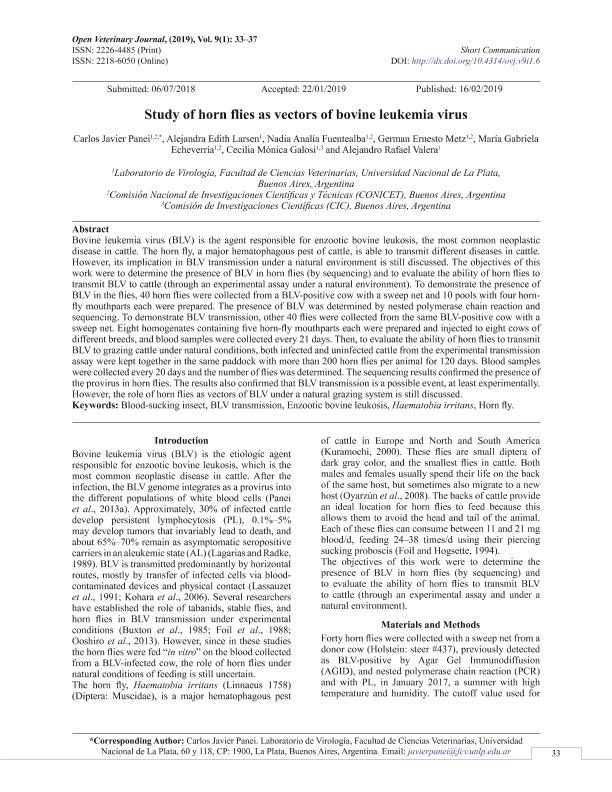Mostrar el registro sencillo del ítem
dc.contributor.author
Panei, Carlos Javier

dc.contributor.author
Larsen, Alejandra Edith

dc.contributor.author
Fuentealba, Nadia Analia

dc.contributor.author
Metz, German Ernesto

dc.contributor.author
Echeverria, Maria Gabriela

dc.contributor.author
Galosi, Cecilia Monica

dc.contributor.author
Valera, Alejandro Rafael

dc.date.available
2020-11-26T14:15:41Z
dc.date.issued
2019-01
dc.identifier.citation
Panei, Carlos Javier; Larsen, Alejandra Edith; Fuentealba, Nadia Analia; Metz, German Ernesto; Echeverria, Maria Gabriela; et al.; Study of horn flies as vectors of bovine leukemia virus; University of Tripoli. Faculty of Veterinary Medicine; Open Veterinary Journal; 9; 1; 1-2019; 33-37
dc.identifier.issn
2226-4485
dc.identifier.uri
http://hdl.handle.net/11336/119092
dc.description.abstract
Bovine leukemia virus (BLV) is the agent responsible for enzootic bovine leukosis, the most common neoplastic disease in cattle. The horn fly, a major hematophagous pest of cattle, is able to transmit different diseases in cattle. However, its implication in BLV transmission under a natural environment is still discussed. The objectives of this work were to determine the presence of BLV in horn flies (by sequencing) and to evaluate the ability of horn flies to transmit BLV to cattle (through an experimental assay under a natural environment). To demonstrate the presence of BLV in the flies, 40 horn flies were collected from a BLV-positive cow with a sweep net and 10 pools with four horn-fly mouthparts each were prepared. The presence of BLV was determined by nested polymerase chain reaction and sequencing. To demonstrate BLV transmission, other 40 flies were collected from the same BLV-positive cow with a sweep net. Eight homogenates containing five horn-fly mouthparts each were prepared and injected to eight cows of different breeds, and blood samples were collected every 21 days. Then, to evaluate the ability of horn flies to transmit BLV to grazing cattle under natural conditions, both infected and uninfected cattle from the experimental transmission assay were kept together in the same paddock with more than 200 horn flies per animal for 120 days. Blood samples were collected every 20 days and the number of flies was determined. The sequencing results confirmed the presence of the provirus in horn flies. The results also confirmed that BLV transmission is a possible event, at least experimentally. However, the role of horn flies as vectors of BLV under a natural grazing system is still discussed.
dc.format
application/pdf
dc.language.iso
eng
dc.publisher
University of Tripoli. Faculty of Veterinary Medicine
dc.rights
info:eu-repo/semantics/openAccess
dc.rights.uri
https://creativecommons.org/licenses/by-nc-sa/2.5/ar/
dc.subject
BLOOD-SUCKING INSECT
dc.subject
BLV TRANSMISSION
dc.subject
ENZOOTIC BOVINE LEUKOSIS
dc.subject
HAEMATOBIA IRRITANS
dc.subject
HORN FLY
dc.subject.classification
Otras Ciencias Veterinarias

dc.subject.classification
Ciencias Veterinarias

dc.subject.classification
CIENCIAS AGRÍCOLAS

dc.title
Study of horn flies as vectors of bovine leukemia virus
dc.type
info:eu-repo/semantics/article
dc.type
info:ar-repo/semantics/artículo
dc.type
info:eu-repo/semantics/publishedVersion
dc.date.updated
2020-11-19T15:43:42Z
dc.identifier.eissn
2218-6050
dc.journal.volume
9
dc.journal.number
1
dc.journal.pagination
33-37
dc.journal.pais
Libia

dc.journal.ciudad
Tripoli
dc.description.fil
Fil: Panei, Carlos Javier. Universidad Nacional de La Plata. Facultad de Ciencias Veterinarias. Departamento de Microbiología. Cátedra de Virología; Argentina. Consejo Nacional de Investigaciones Científicas y Técnicas. Centro Científico Tecnológico Conicet - La Plata; Argentina
dc.description.fil
Fil: Larsen, Alejandra Edith. Universidad Nacional de La Plata. Facultad de Ciencias Veterinarias. Departamento de Microbiología. Cátedra de Virología; Argentina. Consejo Nacional de Investigaciones Científicas y Técnicas. Centro Científico Tecnológico Conicet - La Plata; Argentina
dc.description.fil
Fil: Fuentealba, Nadia Analia. Universidad Nacional de La Plata. Facultad de Ciencias Veterinarias. Departamento de Microbiología. Cátedra de Virología; Argentina. Consejo Nacional de Investigaciones Científicas y Técnicas. Centro Científico Tecnológico Conicet - La Plata; Argentina
dc.description.fil
Fil: Metz, German Ernesto. Universidad Nacional de La Plata. Facultad de Ciencias Veterinarias. Departamento de Microbiología. Cátedra de Virología; Argentina. Consejo Nacional de Investigaciones Científicas y Técnicas. Centro Científico Tecnológico Conicet - La Plata; Argentina
dc.description.fil
Fil: Echeverria, Maria Gabriela. Universidad Nacional de La Plata. Facultad de Ciencias Veterinarias. Departamento de Microbiología. Cátedra de Virología; Argentina. Consejo Nacional de Investigaciones Científicas y Técnicas. Centro Científico Tecnológico Conicet - La Plata; Argentina
dc.description.fil
Fil: Galosi, Cecilia Monica. Provincia de Buenos Aires. Gobernación. Comisión de Investigaciones Científicas; Argentina. Universidad Nacional de La Plata. Facultad de Ciencias Veterinarias. Departamento de Microbiología. Cátedra de Virología; Argentina. Consejo Nacional de Investigaciones Científicas y Técnicas. Centro Científico Tecnológico Conicet - La Plata; Argentina
dc.description.fil
Fil: Valera, Alejandro Rafael. Universidad Nacional de La Plata. Facultad de Ciencias Veterinarias. Departamento de Microbiología. Cátedra de Virología; Argentina
dc.journal.title
Open Veterinary Journal
dc.relation.alternativeid
info:eu-repo/semantics/altIdentifier/doi/http://dx.doi.org/10.4314/ovj.v9i1.6
dc.relation.alternativeid
info:eu-repo/semantics/altIdentifier/url/https://www.ajol.info/index.php/ovj/article/view/183628
Archivos asociados
